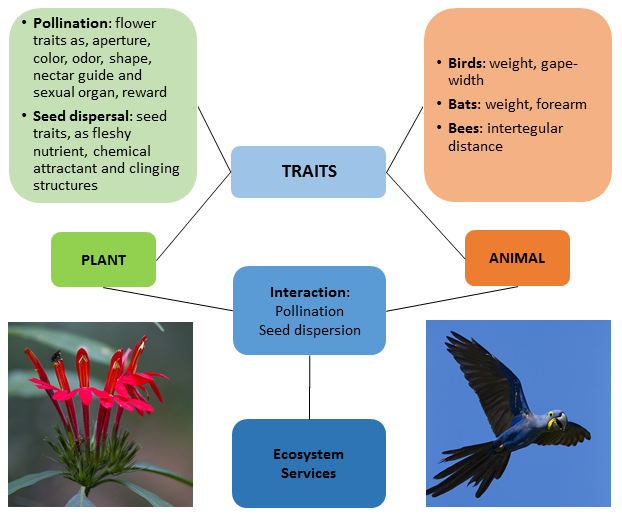|
Biodiversity Information Science and Standards : Conference Abstract
|
|
Corresponding author: Tereza Cristina Giannini (tereza.giannini@itv.org)
Received: 28 Mar 2018 | Published: 21 May 2018
© 2018 Tereza Giannini, Marcelo Awade, Leonardo Miranda, Leonardo Trevelin, Carlos Silva, Rafael Borges, Wilian França Costa, Vera Imperatriz-Fonseca, Antonio Saraiva
This is an open access article distributed under the terms of the Creative Commons Attribution License (CC BY 4.0), which permits unrestricted use, distribution, and reproduction in any medium, provided the original author and source are credited.
Citation: Giannini T, Awade M, Miranda L, Trevelin L, Silva C, Borges R, França Costa W, Imperatriz-Fonseca V, Saraiva A (2018) Role of species: traits, interactions and ecosystem services. Biodiversity Information Science and Standards 2: e25345. https://doi.org/10.3897/biss.2.25345
|
|
Abstract
Understanding the role that species play in their environment is a fundamental goal of biodiversity research, bringing knowledge on ecosystem maintenance and in provision of ecosystem services. Different types of interaction that different species establish with their partners regulate the functioning of ecosystems (
Interactions are mediated by different functional traits (morphological and/or behavioral characteristics of organisms that influence their performance) (
Biodiversity is facing constant negative impacts, especially related to climate and habitat changes. They are threatening the provision of ecosystem services, jeopardizing the basic premise of sustainable development, which is to guarantee resources for future generations. The novel landscapes that result from these impacts will certainly be dependent of these ecosystem services, but will they persist in face of extinctions and invasive competitors? Ultimately, will these services be predicable by functional traits, in landscapes where shared evolutionary history is reduced? Strategies that help our understanding of the interactions and their role in the provision of services are urgent (
The current work focuses on the following groups: plants, birds, bats and bees (Fig.
Interaction and ecosystem services of birds, bats and bees mediated by functional traits (Photos: João Marcos Rosa).
- pollination, which is carried out predominantly by bees, but also by nectarivorous birds and bats; and
- seed dispersal, mainly carried out by frugivorous birds and bats.
These interactions are mediated by key traits. In plants, common flower traits are the aperture, color, odor strength and type, shape orientation, size and symmetry, nectar guide and sexual organ, and reward. Fruit or seed traits, such as fleshy nutrient, chemical attractant and clinging structures, are also relevant for seed dispersal. In animals the most common traits are the body size (for bees, the intertegular distance; for bats, forearm length; and for birds, the weight), gape-width for birds and the feeding habit (nectarivorous, frugivorous, omnivorous) for bats and birds. Providing standardized data on traits involving interactions between fauna and flora is important to fill knowledge gaps, which could help in the decision making processes aiming conservation, restoration and management programs for protecting ecosystem services based on biodiversity.
Keywords
biodiversity, pollinator, seed disperser, functional traits, body size, ecology
Presenting author
Tereza Cristina Giannini
Presented at
Oral presentation
References
-
Size matters: Body size determines functional responses of ground beetle interactions.Basic and Applied Ecology16(7):621‑628. https://doi.org/10.1016/j.baae.2015.06.001
-
How to be a frugivore (in a changing world).Acta Oecologica37(6):674‑681. https://doi.org/10.1016/j.actao.2011.01.005
-
Making dispersal syndromes and networks useful in tropical conservation and restoration.Global Ecology and Conservation6:152‑178. https://doi.org/10.1016/j.gecco.2016.03.002
-
Importance of pollinators in changing landscapes for world crops.Proceedings of the Royal Society B: Biological Sciences274(1608):303‑313. https://doi.org/10.1098/rspb.2006.3721
-
Protecting biostructure.Nature446(7131):29‑29. https://doi.org/10.1038/446029a
-
Safeguarding pollinators and their values to human well-being.Nature540(7632):220‑229. https://doi.org/10.1038/nature20588
-
Closing the seed dispersal loop.Trends in Ecology & Evolution17(8):379‑386. https://doi.org/10.1016/s0169-5347(02)02541-7
-
The role of animal seed dispersal in accelerating native forest regeneration on degraded tropical lands.Forest Ecology and Management99:223‑235. https://doi.org/10.1016/s0378-1127(97)00208-9
